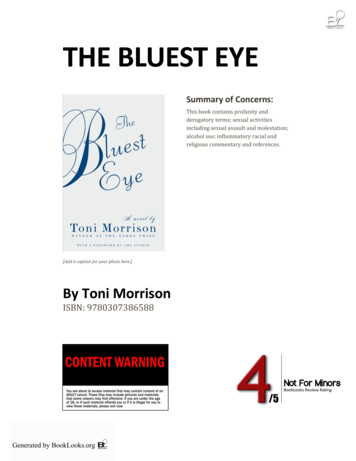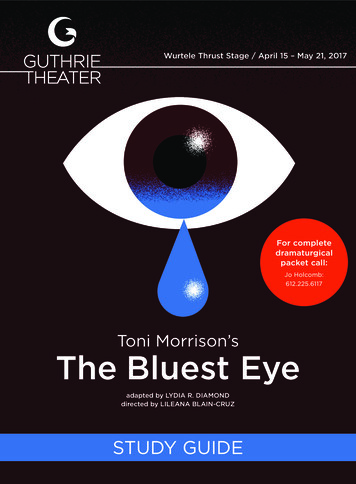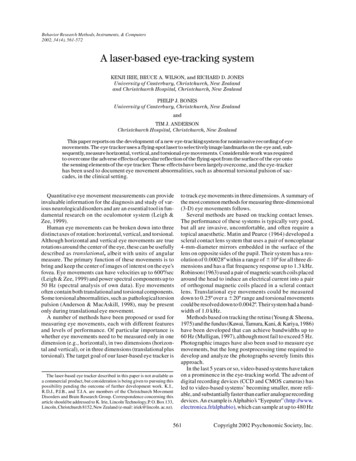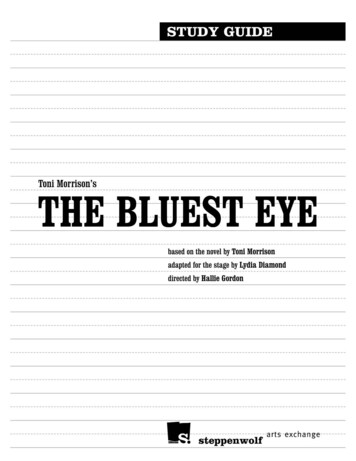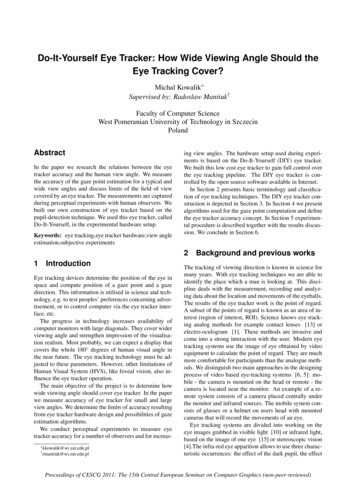
Transcription
INTERNATIONAL JOURNAL OF ENGLISH LANGUAGE, LITERATUREAND TRANSLATION STUDIES (IJELR)A QUARTERLY, INDEXED, REFEREED AND PEER REVIEWED OPEN ACCESSINTERNATIONAL JOURNALhttp://www.ijelr.in (Impact Factor: 5.9745) (ICI)KY PUBLICATIONSRESEARCH ARTICLEARTICLEVol. 9. Issue.1. 2022 (Jan-Mar.)THE BLUEST EYE: A CRITICAL STUDY OF THE BLACK PSYCHOLOGYAJAZ AHMAD BHATEmail:bhatajaz397@gmail.comABSTRACTArticle informationReceived:17/02/2022Accepted: 07/03/2022Published online:12/03/2022doi: 10.33329/ijelr.9.1.98This paper deals with the psychological complexity of Racism and the discourse ofthe white beauty in Toni Morrison’s novel, The Bluest Eye. For this purpose we havetaken a critical study of three characters of the novel: Pecola, Pauline and Claudia.The main question that concerns the novelist is whether the blacks will wake up tothe reality of the situation. Rejection of the White-discourse is viewed as the onlysolution for the future of the black race. The Bluest Eye projects two psychologicalset-ups which go in two contradictory directions. One pattern is concerned with theover valuation of the White-discourse and is followed by Pecola and Pauline, andthe other is concerned with the devaluation of this discourse which is followed byClaudia. Claudia is author’s mouthpiece of how other blacks should behave;Claudia’s rejection of the White-Discourse seems to be the only solution to get ridof the established discourse of the whites.Keywords: Racism, Discourse, Psychology, Race.INTRODUCTIONUndermining the discourse of the white standards of beauty which dates from the ancient times, blackliterature, in recent times, has become a slowly emerging phenomenon. The overvaluation of the whitestandards of beauty goes back to Asiatic religion Manicheism founded by Mani, a Persian in the third century.The religion is based on the struggle of the two eternal conflicting principles: God and matte, or light anddarkness.In the context of America, according to Charles S. Johnson, the concept of blackness has held anunfavorable connotation in the popular mind. “Black is evil, black as sin, black as the devil are the phrases whichsuggest the emotional and aesthetic implications of this association. The evil and ugliness of blackness have longbeen contrasted in popular thinking with the goodness and purity of the whiteness” (Gunner Myrdel 1389). Inother words, black and white are not merely a matter of pigmentation but have come to acquire moralconnotation.The domination of the whites over the blacks in USA was justified as a natural on the grounds that theblacks race was “by nature incapable of being of freedom and marked out for slavery.” A French diplomat andethnologist, Count Joseph Arthur De Gobineau, who is known as the father of racism, maintained this scathingbelief into a theory. “ I have no hesitation in regarding the white race as superior to all others in beauty Human98
Int.J.Eng.Lang.Lit & Trans.Studies(ISSN:2349-9451/2395-2628)Vol. 9. Issue.1. 2022 (Jan-Mar.)groups are unequal in beauty, and this inequality is rational, logical, permanent, and indestructible” (Donald B.Gibson 159).As a consequence, the blacks were treated as subordinates and hence they were reduced to sub humanstatus. The blacks were living human- beings but they were treated as inanimate entities by the whites. It ismotivating spirit which has led many writers to the trace the history of black-women’s writing. Both WilliamFaulkner and Toni Morrison are credited with evolving a language peculiar to the blacks in America.Until the 1940s, black women in both Anglo and African American literature have been usually assignedstereotypical roles. Throughout the novels of slavery and re-construction periods, the Southern white literaturefashioned an image of the blacks intended to further submission and a dumping ground for those black functionswhich a basically Puritan society could not confront. Following the advice Shirley Chrisholm gave in the 1960son the need to speak truthfully and courageously about their plight as women, Morrison in a 1986 interviewasserts: “I write for black women. We are not addressing the men, as some white female writers do. We are notattacking each other, as both black and white men do. Black women writers look at things in an unforgiving,loving way. They are writing to repossess, re-name, re-own” (Sandi Russell 46).As a consequence, the blacks were treated as subordinates and hence they were reduced to sub humanstatus. The blacks were living human- beings but they were treated as inanimate entities by the whites. It ismotivating spirit which has led many writers to the trace the history of black-women’s writing. Both WilliamFaulkner and Toni Morrison are credited with evolving a language peculiar to the blacks in America.The main objective of this paper is to bring out the possible shades and nuances that Toni Morrisonexamines in her critical review of the tragic predicament of the black race. The main question for the novelist iswhether the blacks will wake up to the reality of the situation. All the resources of the novelist in gathering theenergies in writing this novel comes from seeing the degrading of the blacks by the whites; no white should illtreat any black. Morrison has felt the necessity to come out with a graphic account of what is happening amongthe blacks and she also launches into a question of analyzing whether what is happening among the blacks isright or not. The life of the blacks is the subject matter of the theme of Toni Morrison’s novels. There is no joyand calmness in their life on account of the racial discrimination created by the whites. Under thesecircumstances their life becomes very complex. The desire to live a full-fledged life has become impossible forthe blacks. Under the domination of the whites who refuse to give full freedom to them, the word ‘complexity’is used only to denote the failure and struggle of the blacks to have a fulfilling experience. It is this difficulty ofliving with an attitude of fulfillment which is very closely analyzed in the critical review of the novels. Therefore,the three critical terms womanism, racism and their complexity form a kind of running commentary on the tragiclife of the blacks.The novel, The Bluest Eye deals with the pathetic story of a simple black girl Pecola who endeavors tobe as good-looking as the whites in her wish to have bluest eyes. The intensity of grief in Pecola makes herdepressingly a tragic girl and a sad woman as she feels that her complexion does not present a close resemblanceto the white girl or the white woman. The woman in her being is shaken up by her intense consciousness orawareness of her own ugliness which is born out of a certain inferiority complex. The inability of a girl characterlike Pecola in her attempt at feeling being equal to a black in terms of colour and beauty is a particular portrayalof the tragic state of an African woman. Therefore, the tragedy of Pecola is the tragedy of a typical Africanwoman whose average perception of life does not liberate the woman from the plight. In a sense, the entirenovel is a plea for exploring the complexity of African womanism. Each woman character is typically a complexfigure. Both Claudia and Pecola pass through the stage of girlhood. One is timid and submissive but the other isvery courageously rebellious. They undergo two totally different experiences. The coinage of the term AfricanWomanism is helpful in explaining the intense psychological sensibility of Pecola and Claudia. Pecola is a typicalembodiment of an African woman showing a kind of complete submission to the tragic plight of life. But Claudia’swomanhood is expressed in terms of resistance and fight against the white establishment. All the life energiesof the little girl Pecola are spent along the line of acquiring the bluest eye to be good looking as the whites. It isan impossible task but what are unattainable remains to be a main source of attraction for Pecola. While PecolaAJAZ AHMAD BHAT99
Int.J.Eng.Lang.Lit & Trans.Studies(ISSN:2349-9451/2395-2628)Vol. 9. Issue.1. 2022 (Jan-Mar.)is a victim of the white system of values, Claudia is shown by the novelist as a strong denouncer of the samesystem of values imitated by the blacks.The Bluest Eye: Black Segregation and ImitationToni Morrison is considered as one of the greatest novelists of the black literature. Her literature is deeplyconcerned with the welfare of the blacks but she does not spare any efforts or pains to criticize the behavioralshortcomings and limitations of the blacks. If she criticizes the blacks mercilessly, it is because she loves themreally. It is from this standpoint that her portrayal of character and incident must be analyzed. The mostimportant function of the novelist is to indicate the peculiar psychological frame of the blacks. Roughly four orfive characters are placed in simultaneous juxtaposition with each other. In fact one can call such a portrayal anexcellent character gallery. What these characters do to each other is what primarily matters to the novelist. Apronounced attitude is seen in the blacks who distinguish themselves from the other blacks on the basis of theiracceptance of the discourse overvaluing whites. Consequently, such characters look down upon other blackcharacters claiming superiority over them exclusively on the ground of an imitation of a white mandate. Thereis little realization in them to know whether they are right in adopting an alien standard to condemn and turndown their own brethren. A marvelous game of trick is played by the novelist in creating situations where theblacks are critical of the blacks.Toni Morrison shows her brilliance in indicating to the black readers the white frame of cultural reference,which according to her is embodied in the “Dick Jane Mythology”. The unwillingness of parents to attend to achild who loves to play is something which looks very peculiar. A surface reading of the Dick Jane Reader mayapparently seem to capture the spirit of family togetherness and cohesiveness. But what Toni Morrison wantsis a critical reading of the Dick-Jane reader. There is a reference to a dog which shows the white man’s attractionwhich is nothing but a symbol for social sophistication. It can be even said that the mythology contains aconcealed allegory. The parents turning away from the child may be symbolic of the whites turning a blind eyeto the actual welfare of the blacks. Allegorically, in the Dick Jane episode the child is apparently alienated fromthe parents who are not satisfying the desire of the child to play. This description of alienation remains as anundercurrent in the description of the episode but this Dick Jane Reader is projected by the whites to all includingthe blacks as an ideal way of life to be followed. Toni Morrison employs a different kind of deconstructivereading to bring out the hidden implications of what the whites think about the blacks and how they shouldorganize their life in a servile manner. The mythology is very simple but Toni Morrison is very clever in heranalysis because what the mythology meant to the white is one thing and what it meant to the black is anotherthing. It indicates clearly an organized behavior pattern laid down by the whites which should be followed bythe blacks and the rest of the race. The novelist thinks very deeply about the Dick- Jane mythology and shearrives at a conclusion that it is no longer a term of reference for the blacks as they have their culture of theirown, which, if they realize, can furnish an equally enduring pattern of life for them. The mythology by itself doesnot belittle any human conduct. What it shows is a regulated behavior pattern. The episode according to ToniMorrison contains a concealed strategy to keep the blacks in a state of permanent intellectual, mental andphysical slavery. This is a truth to be deciphered by a kind of unconventional and critical reading. Therefore, ToniMorrison says that the same regulated behavior pattern need not be followed by the blacks, however wonderfuland excellent the Dick-Jane mythology might be.The attempt is made by Toni Morrison in the novel “The Blue eye” to demonstrate how Pecola the heroineof the novel yields herself to become a victim of the Dick Jane Mythology. The opening pages of the novelsubscribe to a telling comment on the behaviour pattern of the whites. Pecola becomes a problem to herselfbecause she wants her life to be in tune with the white standards of beauty and dignity.The novel is cast in the form of a drama where two character Pecola and Claudia move in two oppositedirections. The main mission of the novelist is to build up a picture where Claudia acts as a total antithesis toPecola. The program of Claudia is to resist whatever the whites lay down as the values of the blacks. Pecola isshown as a passive victim following the white cultural value system while Claudia is projected as an active fighterchallenging the very concept of the whites.AJAZ AHMAD BHAT100
Int.J.Eng.Lang.Lit & Trans.Studies(ISSN:2349-9451/2395-2628)Vol. 9. Issue.1. 2022 (Jan-Mar.)The experience of cultural discrimination on the basis of colour is the outcome of a long established past.This condition of discrimination is compared to unchangeable and inert matter. Toni Morrison, through Claudia,hints at the fact that this condition of cultural discrimination has come to stay fixed like non- moving physicalmatter or stone. The word fixity implies metaphorically the element of unchangeability in a traditionallyestablished situation where racial discrimination has become an unavoidable fact. But Toni Morrison is of theview that human mind is gifted with the power of creativity to melt the fixity found in the existing cultural orderby radically reviewing and altering it. It is certainly a very remarkable insight on the part of Toni Morrison tocreate a character like Claudia and put forth an existentially meaningful passage in her mouth. Many blackcharacters like Cholly Breedlove, Pauline and Pecola have no independence of judgment and originality of vision.The greatest tragic error is that they humiliate themselves in an unwarranted manner. The humiliation is a selfcreated psycho-neurosis from which the blacks suffer.The phenomenon called psycho-neurosis is easily applicable to characters like Pecola and Pauline. Whatis meant by psycho-neurosis is the failure to face reality. So long as one follows a mirror image of someone else’sone is not true to oneself. The actual problem is that the black characters like Pecola and Pauline have no faithin themselves and in their own choices of life. What comes to them is what they receive from outside. Actuallywhat comes from outside is the reflection of the white mirror. The white mirror for a black becomes a mandateto them. It implies that the white mandate should be followed without any questioning. It is this unquestioningacceptance in the life of Pecola and Pauline that the novelist points out as a tragic event. Therefore this psychoneurosis is the condition of hopelessness which is partly self-created and mostly imposed upon the blacks by thewhites. The pre-established view is that what is aesthetically pleasing is what deserves the status of love. This isthe image from which the black characters like Pecola and Pauline are not able to get rid of themselves. Thewhite mandate according to the novelist is fraught with sinister consequences. There are obvious references inthe novel which are put through Pecola, Pauline, Geraldine, Junior and Maureen Peal that the white mandate isthe model. Only a very shrewd and formidably forward looking character is created by the novelist in order todevalue the white mandate.Racism is a big problem. But internal racism is even a bigger problem. The main reason is that the externalracism is blindly accepted by the black insiders without little realizing that the blacks are not alive to the realissues (the whites have suppressed the blacks for centuries and that the blacks must be free from this slavery).What the whites have done to the blacks is different from what some of the blacks have done to their ownblacks. This is a shameful internal racial situation which is projected in some other incident also. The mostpeculiar thing is that Maureen seems to be much more beautiful than other characters. This is a pride bred byher adherence to white standards. The actual truth is that the white characters will never appreciate a blackcharacter like Maureen. What happens when a light-skinned black character is brought into juxtaposition withanother black character, a new psychology is in operation (light - skinned blacks believing in their superiorityover the dark - skinned blacks):That they themselves were black or that their own father had similarly relaxed habits was irrelevant. Itwas their contempt for their own blackness that gave the first insult its teethCONCLUSIONThe main plan of the paper lies in showing the agony of the blacks who live in a state of emotionalunfulfilment. The reason is largely traceable to the conditions of life which are determined by the whites whouse the blacks for their convenience and welfare. It is this story of the blacks who live in subordination to thewhites which is discussed in terms of race, class and gender. The word Complexity carries the inner implicationsof the social and psychological struggle which the blacks experience. Their life is not so simple as they desire itto be. It has become tremendously complex as there is no possibility for a life of joy and vitality. The main themeof the novels of Toni Morrison is concerned with the destiny of the black race. A careful selection of the twonovels indicating the problems arising in the life of the black race has been made. The objective of such anendeavor is only to highlight some basic issues connected with the psychology and the sociology of the blacks.Anyway, the black cultural sociology is yet to evolve into a new scheme. Till it sees the light of the day the blacksAJAZ AHMAD BHAT101
Int.J.Eng.Lang.Lit & Trans.Studies(ISSN:2349-9451/2395-2628)Vol. 9. Issue.1. 2022 (Jan-Mar.)cannot feel proud to achieve an emancipation. Their complacency, a kind of smug self-satisfaction with theexisting conditions of life, some enduring the whites, some imitating the whites, some claiming and feelingsuperior to the blacks in spite of their being the blacks are matters of contradiction to the novelist as they remainin ignorance and unenlightenment. In fact, every novel of Toni Morrison is meant to be a lesson to learn forevery black. It is a deep reading of the psycho-pathology of the black race. The minds of the blacks are warpedand twisted by the values imposed on them by the whites. In the language of Freud neurosis and psychopathology are nothing but failures on the part of anyone to face reality and come to terms with it. This isapplicable to the blacks because they are yet to see the reality. What they now see is only a mirror of reflectionof reality shown by the white system of values.BibliographyPrimary SourcesMorrison,Toni. The Bluest Eye, Vintage, 1999.Secondary SourcesAna, Maria, and Fraile Marcos. “Hybridizing the “City Upon a Hill in Toni Morrison’s Paradise,” Melus Vol.28 No.4,2003, pp.3-33Bradbury, Malcolm and Palmer David. eds., The American Novel in The Nineteen Twenties. Arnold, 1971.Carmean, Karen. Toni Morrison’s World of Fiction. The Whitson Publishing Company, 1993.Grewal, Gurleen. Circles of Sorrow, Lines of Struggle: The Novels of Toni Morris, Louisiana State University Press,1998.Gunnar, Myrdel. An American Dilemma: the Negro Problem and Modern Democracy, Harper and Row, 1962, pp.1382.Donald B. Gibson. Text and Counter text in The Bluest Eye, Gordon and Breach Science, 1989, pp.159.AJAZ AHMAD BHAT102
The Bluest Eye: Black Segregation and Imitation Toni Morrison is considered as one of the greatest novelists of the black literature. Her literature is deeply concerned with the welfare of the blacks but she does not spare any efforts or pains to criticize the behavioral shortcomings and limitations of the blacks.




